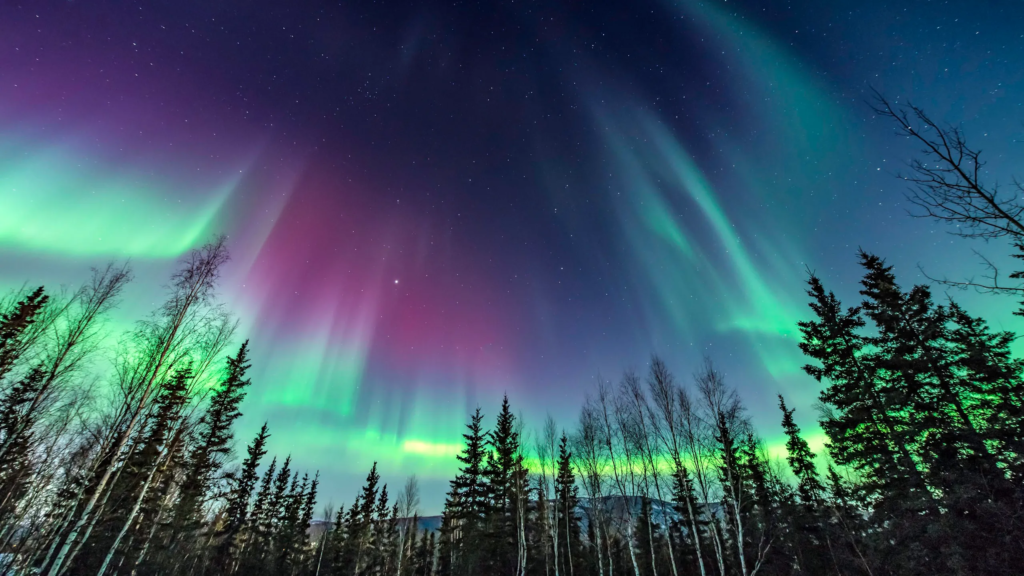Aurora 2025 Northern Lights” stunned people around the world this year—these vivid, dancing lights appeared in skies far beyond the usual Arctic or Antarctic regions. From mid‑latitude cities to tropical zones, unexpected viewers got to witness this celestial spectacle. In this article, we explore what triggered these unusual auroras, where they were seen, and how you could spot them moving forward.
1. What Are the Aurora 2025 Borealis and Aurora Australis?
The Northern Lights (Aurora Borealis) and Southern Lights (Aurora Australis) are luminous displays caused when energetic particles from the sun collide with Earth’s atmosphere. The collisions excite gases, producing shimmering curtains, arcs, and waves of green, red, purple, and blue light.
- Typical zones: These are usually seen near the polar regions, within the “auroral oval.”
- Causes: Solar flares and coronal mass ejections (CMEs) launch charged particles toward Earth; the planet’s magnetic field guides them toward the poles.
2. Why Was 2025 an Unusual Year?
Several factors combined to create unprecedented visibility of the Aurora in 2025:
a) Exceptional Solar Activity
Scientists reported a series of powerful solar storms in early 2025—solar flares, associated CMEs, and strong solar wind gusts. These heightened events caused significant auroral expansion beyond normal latitudes.
b) Geomagnetic Storms
Major geomagnetic storms, rated G4 (“Severe”) on the NOAA scale, caused strong compression of Earth’s magnetosphere. That brought auroras visible much farther from the poles than usual.
c) Optimal Earth–Sun Alignment
Some storms coincided with favorable Earth–Sun magnetic alignment, amplifying the effect. The result: auroras reached as far south as the tropics.

3. Where Were Auroras Seen?
People were treated to Aurora shows in truly unexpected locations:
- Southern Europe & Mediterranean: Reports from Spain, Italy, Greece—regions that seldom see these lights.
- Middle East & North Africa: Strange sightings in Egypt, Saudi Arabia, and even parts of southern Turkey.
- Asia: Unusual auroral glows in India (northern states) and parts of Southeast Asia.
- Americas: Beyond the typical Canada and Alaska, auroras showed briefly in the U.S. mid‑Atlantic and even parts of Mexico.
- Tropical Zones: There were verified cases of faint auroral arcs seen near the equator—an awe‑inspiring rarity.
4. Eyewitness Accounts (Selected Highlights)
Here are a few vivid stories:
- Madrid, Spain: “It looked like ribbons of green swept across the night sky,” said a photographer who captured the event.
- Cairo, Egypt: “It was surreal — faint reds and greens, I never thought I’d see this here,” recalled an amateur astronomer.
- New Delhi, India: “A faint glow to the north, like a flickering rain of light, then vanished,” said a resident checking the northern horizon.
These firsthand accounts highlight how extraordinary the auroras of 2025 were.
5. Science Behind the Spread
How Geomagnetic Storms Expand Auroral Visibility
Severe geomagnetic storms disturb Earth’s magnetic field lines, pushing the ‘auroral oval’ toward lower latitudes. In 2025, several storms were strong enough to make this shift dramatic.
Role of the Solar Cycle
We are moving toward solar maximum (predicted late 2025 or early 2026). Solar maximum periods bring more frequent and intense solar eruptions, increasing the likelihood of such widespread auroras.
Comparisons to Past Events
While auroras have reached mid‑latitudes before (for example, during the Carrington Event of 1859), modern sightings across the tropics are exceptionally rare. The combination of strong solar output and sensitive satellite monitoring enabled this year’s unusual visibility.
6. Why It Matters
Public Awareness & Scientific Monitoring
These auroras raised public interest in space weather. Governments and space agencies increased monitoring to issue timely alerts during such events.
Potential Impacts
Aside from the beauty, powerful geomagnetic storms can disrupt:
- Satellite communications and GPS
- Power grids (inducing currents in long conductors)
- Aviation routing (especially over polar and now mid‑latitude zones)
Notably, in 2025, some airlines rerouted polar flights temporarily to avoid communication blackouts.
7. How You Can Watch Future Auroras
a) Stay Informed
Subscribe to space weather alerts from agencies like NOAA, ESA, and your national space authorities—especially around the solar maximum period.
b) Know When to Look
Auroras are most visible during clear, dark nights, away from city lights. Even mid‑latitude areas may catch them if conditions align.
c) Use the Right Tools
A good camera with a wide aperture lens (ƒ/2.8 or lower), tripod, and long exposure can help capture faint auroras—even when your eyes only see a faint glow.
d) Join Astronomical Communities
Local astronomy clubs often organize aurora‑watch events and can notify members when extraordinary activity is expected.
8. 2026 and Beyond – What to Expect?
As we near solar maximum, we can expect more energetic solar flares and geomagnetic storms. While not every storm will produce stray auroras in low latitudes, the possibility remains higher during this period.
Long term, continued satellite data and improved forecasting models help us better predict auroral expansion—making such rare sights more accessible to people beyond the poles.
9. Final Thoughts
The Aurora 2025 Northern Lights event has been a vivid reminder that nature can surprise us—and not always in the places we expect. For many, seeing auroras in previously aurora‑free skies was a once‑in‑a‑lifetime opportunity.
These skyborne wonders also spotlight the dynamic interactions between our planet and the sun—and why staying informed, prepared, and observant matters. Whether you’re in the Arctic or the tropics, the night sky can still put on a magnificent show.
Let this inspiring 2025 display spark curiosity—and maybe next time, your location will be one of the “unexpected skies” to host a celestial ballet of color.
Do Follow USA Glory On Instagram
Also Read : Gen Z Mental Health Trends: Sleep maxxing, Pets & Community






